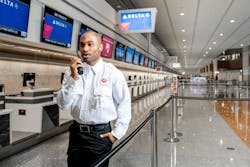Aviation Security, Keeping Insider Threats Out
Aviation security is both crucial and complex. While Transportation Security Administration (TSA) checkpoints may be the most public-facing, security measures run deep through an operation, often outside of the public eye.
From cyber security threats and malicious actors to an employee forgetting to leave a pocketknife in their car when they clock in, possible threats run the gamut.
According to Everett Deanes, security general manager for Unifi, trying to guess what the next threat might be is like trying to see the future.
“The criminal element is always crafty. That’s almost like making a prediction, on my part. What is the next threat going to be? There are many past security risks that have threatened airports and passengers that modify the way we adjust our procedures,” Deanes says.
“I think collaborations amongst the law enforcement and the aviation field is probably the only way that we’re going to be able to mitigate security threats.”
Threat Anticipation
The first step to assessing what threats an operation should prepare for is to brainstorm as many different scenarios as possible.
“You have to sit down and do roundtables and talk it out and try to come up with potential threat scenarios. When I was in law enforcement, we would talk about different scenarios, many of which would come into play. They key is to always be prepared and be able to come up with a basic scenario to hamper whatever situation arises,” Deanes says.
Broadly, threats fall into two categories: terrorist and insider. In both categories, security teams work with TSA agents and local law enforcement to make sure they are providing the best intelligence possible.
Deanes explains that terrorist threats originate from organized groups and those people associated with them. Since 9/11, those threats have been at the forefront of the flying public’s mind and the potential harm they can cause is obvious.
Rouge employees are those who are not affiliated with any group, but act on their own accord. These could include a disgruntled employee who commits an act of sabotage or plays a prank, or an employee stealing from the work site.
Theft is common crime committed by rogue employees. Deanes says people may be surprised that it’s not what an employee enters with that is the problem, but what they try to leave with.
“You would be amazed at what is pilfered at locations. People go in with nothing, but they sometimes come out with things that don’t belong to them,” he says.
The key to anticipating these different possibilities is, when brainstorming possible scenarios, nothing can be ruled out no matter how outlandish it may seem during initial conversations.
“Who ever thought that we’d have an underwear bomber or who ever thought we’d have a shoe bomber?” Deanes points out, adding it’s better to have measures in place and not need them than to need them and not have them.
However, Deanes notes that the most common threats are those of airport employees bringing prohibited items to work — and not necessarily with malicious intent in mind, but having merely forgotten the item was on them or not realizing the item isn’t allowed inside.
“During our screening procedures, we recover prohibitive items from employees that shouldn’t be brought on the airfield,” he says.
Possible items can include knives and guns, or self-defense items such as mace and pepper spray.
Evolving Threats, Evolving Security
As the possibility and scope of potential threats have grown, so has the technology to prevent them.
Technologies and methods such as having employees walk through metal detectors, using X-ray machines and doing bag searches have become more common place.
Deanes says this was not always the case.
“Many years ago, prior to modern mitigation efforts and technologies, it was a lot more difficult to catch insider threats. Our newer technologies and continually evolving security procedures have made our workplaces, and the skies, safer for everyone,” Deanes explains.
“Screening is one of the most effective ways to prevent threats from materializing and is something that an operation should be instituting. What has seemed to be very effective for us and for the airlines that we deal with, is screening employees.
“Screening and reverse screening can save the airlines and other employers a lot of money and effort. By screening all airport staff, we catch a lot of prohibited items, whether intentional or unintentional,” Deanes says.
But even with the increased use of technology, Deanes stresses that the human factor cannot be removed.
People are often the best at recognizing and preventing possible threats and assessing when a situation is actually benign despite a machine flagging it otherwise.
Human intuition is a key component, Deanes stresses.
“One of our best tools that we actually use are cameras, but you always have to have the human factor to show up to verify or to check out what is actually happening during those situations,” Deanes adds.
The human element of security can start as soon as the hiring process begins as long as interviewers are trained for what to look for, according to Deanes.
Although background checks are part of the equation of hiring the right employees, no background check is perfect.
Deans says this is why it is important to have an extensive training program on how to properly interview employees.
“One thing to do is to train your managers, or people who are actually doing these interviews, on how to interview people properly. That sometimes comes from some of my training that I received. When I’m sitting there and interviewing people and I’m asking them questions, and they look right or if they look left and learning how to do deep dive, do follow-up questions.
“I think that when interviewers are properly trained on how to pick up these cues, they find out that certain applicants might not be the right person for a job” Deanes says.
An operation should aspire for employee retention. When employees are trusted and retained, an organization doesn’t have to fret over having a revolving door of unknown persons entering and exiting their facilities.
“Not only do you want an employee who’s trustworthy and has the right character, but you also want a long-term employee. And that goes a long way when you’re conducting interviews,” Deanes says.
However, there is no one-size-fits-all approach. At the end of the day, an operation needs to layer its security measures to be successful in stopping possible threats.
“The only thing I can say is continue to add layers of security. And when I talk about layers of security, I mean start with the basic layers; educating the workforce, using technology to your advance such as x-rays, the metal detectors, explosive trace detection machines, training employees not to accept the norm, meaning that if you see something, say something. That was a big campaign back in the day,” Deanes says.
“Those are some of the things that I would say would help you prepare for the future.”
About the Author
Walker Jaroch
Editor
Contact: Walker Jaroch
Editor | AMT
+1-920-568-8399
>> To download the AviationPros media kits, visit: Marketing Resource Center
>>Check out our aviation magazines: Ground Support Worldwide | Airport Business | Aircraft Maintenance Technology

